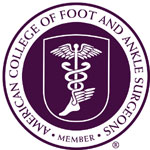Treating Toenail Fungus in Frisco, Texas

Toenail fungus, which medically is termed onychomycosis, is a common condition that can cause changes to the thickness and color of a nail. Fungus, in general, is an organism that likes moist and dark environments, just like how we can find in our shoes! Wearing shoes, especially when snug, can cause repeated friction and microtrauma which can cause nails to lift up. This lifting of the nail allows fungus to enter and infect the nail.
Toenail fungus symptoms include discoloration and thickening of the nail. The affected nail may become brittle and separate from the nail bed. You may notice debris (buildup) underneath the nail. Sometimes the nail can even have an odor. The nail may become painful as it continues to thicken, which can be worsened with certain shoes. Often, we see toenail fungus in combination with Athlete’s Foot (a fungal infection of the skin).

Although anyone can contract toenail fungus, there are certain groups that are more at risk than others including those who are immunocompromised, have diabetes, and are elderly. People with poor circulation are also more prone to a fungal infection of the toenails. We also see toenail infections more commonly in those with excessive sweating of the feet and Athlete’s Foot infections.
Without treatment, the toenail fungus will likely spread to other toenails. There are multiple types of treatment options:
- Oral medications, depending on the medication, offer success rates of up to 76%. These antifungal pills often have predictable and successful results. Typically, these require about a 12 week course of treatment and improvement to the nail is noticed as it grows out. As with any oral medication, although uncommon there are risks. We require routine bloodwork to be done to ensure that there are no side effects particularly on the liver or blood cell count.
- Topical medication includes creams and medicated nail lacquers. Overall, these are not quite as effective as oral medication but are an option if there are contraindications or hesitancy to taking antifungal pills. Topical medications tend to work better on more mild nail infections. With use of topical medication, we recommend regular nail trimming.
- Laser therapy is another option for treating toenail fungus. Laser therapy typically involves 4 weekly sessions of 12 minutes of laser exposure, which is relatively painless. Research has shown to have approximately 67% efficacy rate, with some sources even higher than this.
- Nail Removal is a last choice option for severe nail thickness. This involves a minor procedure in the office where the affected toe is numbed with anesthesia and the nail is removed. Regardless of the treatment option there is always a chance of recurrence.
There are certain steps that can be taken to help prevent toenail fungus. These include:
- Changing socks regularly, especially throughout the day if you have sweaty feet
- Avoiding being barefoot in public areas, especially damp areas like showers/saunas/etc
- Ensuring that clean instrumentation is used when cutting nails/getting a pedicure
- If noticing any signs of Athlete’s Foot (fungal skin infection) seek prompt treatment
- Wearing shoes that fit your feet well
- Wearing shoes with material like mesh that breathes well
- Wearing moisture wicking socks
- Having toenails well trimmed
- Seeing a podiatrist in a timely manner when noticing changes in nail color or thickness
If you have any concerns about possible toenail fungus, make an appointment with Star Foot & Ankle Specialists and have Dr. Heredia and Dr. Zellers find the best treatment for you!
Schedule an appointment by clicking here




